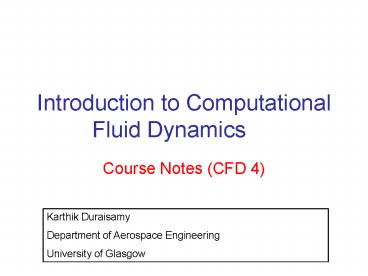Introduction to Computational Fluid Dynamics PowerPoint PPT Presentation
1 / 36
Title: Introduction to Computational Fluid Dynamics
1
Introduction to Computational Fluid Dynamics
- Course Notes (CFD 4)
Karthik Duraisamy Department of Aerospace
Engineering University of Glasgow
2
Contents
- Introduction (1.5)
- Classification of PDE, Model equations (1.5)
- Finite difference methods
- ? Spatial discretization (3)
- ? Temporal discretization (2)
- ? Convergence, Consistency, Stability (2)
- Grids/Boundary conditions (1)
- Euler equations (1)
- RANS Equations and Turbulence modeling (2)
- DNS/LES (1)
- Best practices in CFD (1)
- Case studies/Demonstrations (3)
(.) Approximate number of lectures
3
- CASE STUDIES
4
Best practices in CFD
- Selection of Problem/model/numerical method
- Feasibility study of computation
- Identifying physics and required resolution in
different parts of the mesh - Grid convergence
- Time step convergence (unsteady)
- Verification/Validation
- COMMENT YOUR CODE!!! ?
5
What do you plot?
- Line graphs (x vs Cp)
- Contours (Velocity magnitude in a section)
- Iso-surfaces (Vorticity magnitude)
- Streamtraces (Streamlines)
- Spectra (Energy spectra)
6
- CASE STUDY 1
7
Fixed wing validation
- M0.15, Re4.5x106, a10o, AR0.75, rounded tip.
- Extensive mean and turbulence measurements by
Chow et. al. 1997 - Surface (pressure tabs) and wake measurement
(pressure probes and hot wires) up to 0.68c. - Resolution good enough to compare flow viz with
numerics.
8
Surface pressure distribution
y/c0.667
y/c0.583
f45o
f90o
f
9
Axial Velocity (x/c-0.394)
Computation
Experiment
10
Axial Velocity (x/c-0.114)
Experiment
Computation
11
Axial Velocity (x/c0.005)
Experiment
Computation
12
Axial Velocity (x/c0.678)
Computation
Experiment
13
RANS/Inviscid Comparison
Swirl velocity
14
- CASE STUDY - 2
15
Why study tip vortices?
16
Application of Spanwise blowing
- Baseline test case of Heyes et al. (Imperial
college) - AR1, NACA0012 wing section, a7.5o, M0.1,
Re2.2x105. - Spanwise blowing Velocity measurements x/c1
downstream of trailing edge. - Blowing co-efficient
17
Validation Baseline case, x/c1
18
Blowing test cases
19
Validation Blowing case C1, x/c1
20
Physics of control
Axial Vorticity
x/c0.21 (from l.e.)
Freestream direction
21
Case C1 x/c-0.95
22
Case C1 x/c-0.85
23
Case C1 x/c-0.75
24
Case C1 x/c-0.45
25
Case C1 x/c-0.25
26
Case C1 x/c-0.1
27
Case C1 x/c1.0
28
Blowing case C1
29
Blowing case C1
30
Different blowing rates
Core radius
Peak swirl velocity
Effectiveness of blowing weak function of
blowing angle
31
- CASE STUDY -3
- Some thoughts from 30 years of Development and
Application of CFD at Boeing - - Johnson et al., Computers and Fluids.
32
Role of CFD
- CFD has joined wind tunnel and flight testing as
primary tool - Flight testing Too expensive, but real data
- Wind tunnel Good flight envelope, accurate, but
low Re, but effect of mounting, walls, not enough
detail - CFD Inexpensive, used in optimization,
extrapolation of tunnel data to flight conditions
and detailed understanding, but somewhat
inaccurate. - CFD Very useful in design of high speed cruise
configuration of full transport aircraft
33
Well..
34
Role of CFD
35
Contribution of CFD in 777 design
36
Use of CFD

